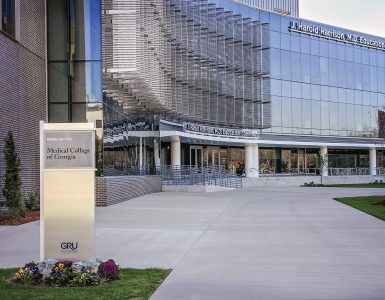Though I could easily fill this column with praise for the hard work, dedication and leadership our faculty, staff and remarkable students have demonstrated during the year-plus fight against COVID-19 — and let me be clear: I am incredibly proud of the work we’ve done — I’d like to use this space instead to look forward and talk about what I feel is potentially the most exciting research opportunity in the history of this university. It’s called TRIBA — the Transdisciplinary Research Initiative in Inflammaging and Brain Aging — and it promises to be a game changer not only for us, but for the health of those we’re entrusted to protect.
This exciting new initiative, which came from the faculty, will explore the ways chronic inflammation impacts aging so that we can improve health outcomes for people suffering from Alzheimer’s, dementia and other age-related diseases. It will be supported by an aggressive three-year, $15 million investment to recruit between 15 and 20 new faculty researchers, building on our already significant strengths in aging, neuroscience and vascular biology. A further investment of $5-$15 million in research facility renovations will follow.
While these new researchers will primarily reside in the Medical College of Georgia, this cluster hire will be spread over five other colleges and schools — the Dental College of Georgia, the College of Science and Mathematics, the colleges of Nursing and Allied Health Sciences, and the School of Computer and Cyber Sciences — making it a multidisciplinary collaboration in the truest sense. The recruitment steering committee is being led by Dr. Babak Baban, immunologist and associate dean for research in DCG, and Dr. Mark Hamrick, bone and muscle biologist and senior associate dean for research in MCG. Both have already made significant contributions to the study of age-related inflammation. Dr. Baban and a team of investigators from MCG and DCG recently reported on CBD’s role in reducing inflammation and plaque levels associated with Alzheimer’s, and Dr. Hamrick is part of an $11.1 million Program Project grant from the National Institutes of Health exploring the role oxidation plays in age-related damage to bone, which has implications for brain health as well. Thanks to the hard work of researchers from several areas of our institution, funding from the National Institute on Aging has increased threefold in the last 10 years, and we want to capitalize on that in a big way.
Why the focus on inflammaging and brain aging? Because seldom do you find something that offers so many benefits to so many people in so many different ways.
First, consider the benefit to our patients, who along with our students are always our first priority. By the year 2030, the entire Baby Boomer generation will be over 65 years old, and while many adults are expected to live to 85 or beyond, there is little evidence to support the idea that these additional years will be better years, given the prevalence of age-related diseases. Though we know that most age-related diseases, including cardiovascular disease and hypertension, involve inflammation, much about inflammation remains unknown, including its potential cause and its role in adverse health outcomes. The related field of brain aging includes specific aspects of inflammation within the brain and how that affects cognitive activities and disease progression.
Concentrating on this area of study allows us to build on our existing research expertise in brain injury and learning and memory disorders to help move the needle on these serious health concerns disproportionately affecting Georgians, particularly minority and underserved populations. In doing so, we can also kick start our research enterprise, which we all know is not where we’d like it to be. Because we anticipate significant opportunities to compete for funding in this area, this initiative will be a major driver in our effort to bridge the $14 million gap in NIH funding that will bring us into the top 60 ranked medical schools in the country, a goal I want us to achieve by 2030.
The initial faculty for this interdisciplinary cluster hire will be located on the fourth floor of the new College of Science and Mathematics building, located on the Health Sciences Campus. Thanks to efficiencies in other parts of the project, we were able to build out the shelled space with money allocated for the initial project, giving us an additional 20,000-square-feet of much needed research space. Here, investigators can collaborate with each other in a building primarily populated by undergraduates, giving these young students valuable opportunities to explore a future in research.
I’m excited about the impact this new initiative will have on the health of Georgians and on the research ranking of this university. Expect to hear a lot more about this in the coming months as we work toward making this vision a reality.
Sincerely,
Brooks Keel, PhD
President, Augusta University
Chair, Augusta University Medical Associates










